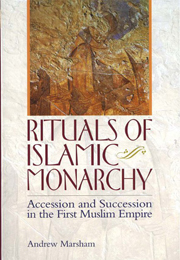Book contents
- Frontmatter
- Contents
- List of maps and figures
- Acknowledgements
- Map 1
- Map 2
- Map 3
- INTRODUCTION
- PART I LATE ANTIQUE ARABIA AND EARLY ISLAM (c. 550–c. 660)
- INTRODUCTION
- 1 ALLIANCE AND ALLEGIANCE IN PRE-ISLAMIC ARABIA
- 2 THE VERB BĀYAcA IN THE QURɔĀN: ALLEGIANCE TO MUḤAMMAD
- 3 THE OATH OF ALLEGIANCE IN THE ‘CONQUEST SOCIETY’ (c. 628–c. 660)
- PART II THE UMAYYAD CALIPHATE (c. 660–750)
- PART III THE EARLY ABBASID CALIPHATE (c. 750–809)
- PART IV THE MIDDLE ABBASID CALIPHATE (809–865)
- CONCLUSION
- Genealogical table of Quraysh
- Genealogical table of the Abbasid caliphs
- Bibliography
- Index
INTRODUCTION
from PART I - LATE ANTIQUE ARABIA AND EARLY ISLAM (c. 550–c. 660)
Published online by Cambridge University Press: 05 September 2013
- Frontmatter
- Contents
- List of maps and figures
- Acknowledgements
- Map 1
- Map 2
- Map 3
- INTRODUCTION
- PART I LATE ANTIQUE ARABIA AND EARLY ISLAM (c. 550–c. 660)
- INTRODUCTION
- 1 ALLIANCE AND ALLEGIANCE IN PRE-ISLAMIC ARABIA
- 2 THE VERB BĀYAcA IN THE QURɔĀN: ALLEGIANCE TO MUḤAMMAD
- 3 THE OATH OF ALLEGIANCE IN THE ‘CONQUEST SOCIETY’ (c. 628–c. 660)
- PART II THE UMAYYAD CALIPHATE (c. 660–750)
- PART III THE EARLY ABBASID CALIPHATE (c. 750–809)
- PART IV THE MIDDLE ABBASID CALIPHATE (809–865)
- CONCLUSION
- Genealogical table of Quraysh
- Genealogical table of the Abbasid caliphs
- Bibliography
- Index
Summary
The great political achievement of Muḥammad and his seventh-century successors was the creation of a sustainable political unity that brought together the settled population of the Arabian Peninsula and the tribes of pastoral nomads that dominated the steppes of Syria and Iraq. It was a feat that was unprecedented and unrepeated in Arabia in both scale and consequence: never before had the whole Peninsula come under the political domination of one power, nor had an Arabian federation ever founded such a vast and long-lasting empire.
According to the extant, ninth- and tenth-century sources, loyalty and allegiance within the Muslim polity were publicly communicated in a ritual usually described as the bayca, or ‘pledge of loyalty’. The expression of allegiance through such oaths is one of the great long-term cultural continuities of the premodern Near East (and arguably of Eurasian civilisation as a whole). Covenants for alliance and allegiance were the basis upon which pre-modern empires were built, and the same basic concepts informed the Islamic ‘oath of allegiance’ as most other oaths of allegiance in the pre-modern world: the weaker party swore to obey the stronger under the sanction of divine punishment for disloyalty and the promise of reward for fulfilment of the oath. In the Muslim polity the pledge was guaranteed by Allāh, the monotheist deity whom the Muslims' leaders represented.
The most significant obstacle to recovering the history of such oaths among the earliest Muslims is the nature of the available evidence.
- Type
- Chapter
- Information
- Rituals of Islamic MonarchyAccession and Succession in the First Muslim Empire, pp. 21 - 23Publisher: Edinburgh University PressPrint publication year: 2009



